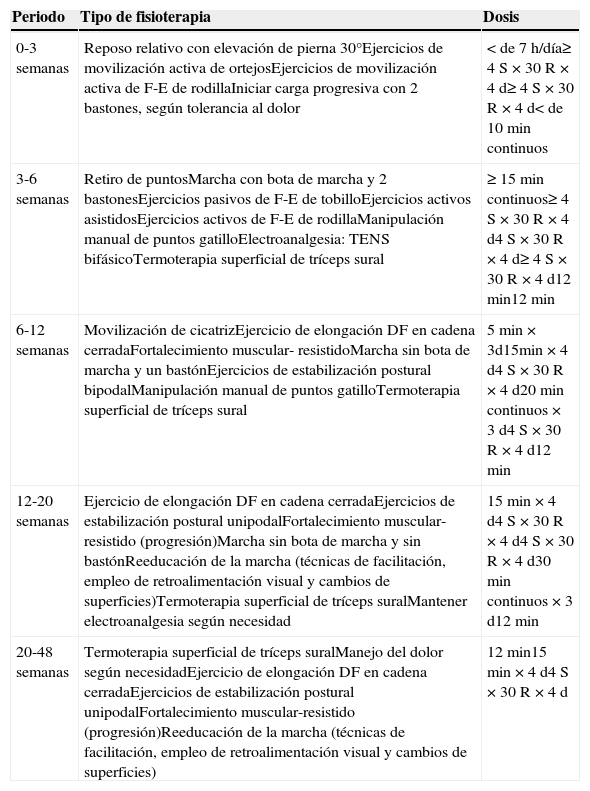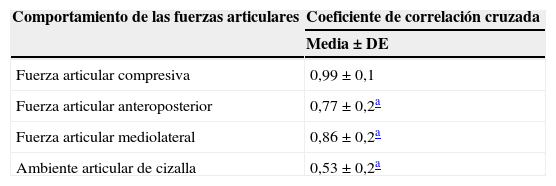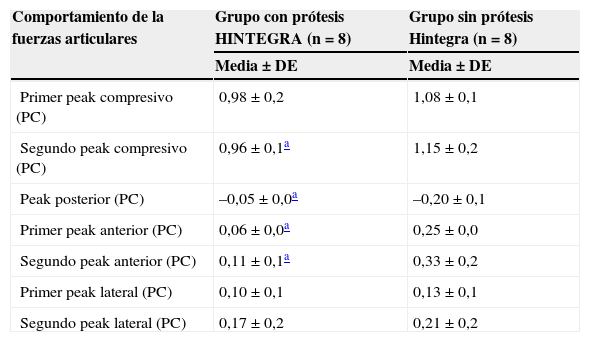El objetivo de nuestra investigación fue describir en fase funcional, la restauración del comportamiento de las fuerzas articulares de tobillo y sus factores mecánicos durante la marcha en sujetos con reemplazo articular total de tobillo con prótesis HINTEGRA unilateral de origen postraumático.
Material y métodosDieciséis sujetos de sexo masculino, 8 con prótesis HINTEGRA unilateral de origen postraumático y 8 sujetos sin prótesis HINTEGRA, se sometieron a un análisis de marcha. El comportamiento de las fuerzas articulares de tobillo y sus factores mecánicos fueron obtenidos. Se empleó un análisis de correlación cruzada junto a la prueba U Mann-Whitney no pareada (α = 0,05).
ResultadosExistió significación estadística con un menor coeficiente de correlación cruzada en la fuerza articular anteroposterior, mediolateral y ambiente articular de cizalla; menor segundo peak compresivo, peak posterior, primer peak anterior, segundo peak anterior, tiempo de segundo peak vertical, peak de momento plantiflexor, y mayor tiempo de primer peak vertical en sujetos con prótesis HINTEGRA.
ConclusionesLos resultados indican que sujetos con prótesis HINTEGRA de origen postraumático presentan alteración del comportamiento de las fuerzas articulares de tobillo durante fase functional, generando una ineficiente función amortiguadora y de propulsión, creando un ambiente patomecánico de cizalla predisponente de un mayor desgaste de la interface en fase funcional.
The objective of our research was to describe the recovery behavior of the ankle joint forces and their mechanical factors during gait in subjects with total ankle replacement with unilateral HINTEGRA prosthesis secondary to trauma during the functional phase.
Material and methodsSixteen male subjects, 8 with unilateral HINTEGRA prosthesis secondary to trauma and 8 subjects without HINTEGRA prosthesis underwent gait analysis. The ankle joint forces behavior and its mechanical factors during gait were obtained. A cross correlation analysis was used with a non-paired Mann-Whitney U test (α = 0.05).
ResultsThere was statistical significance with a smaller cross-correlation coefficient in the anteroposterior, mediolateral joint forces and in shear force environment; lesser second compressive peak, posterior peak, first anterior peak, second anterior peak, time of the second vertical peak, plantar flexion moment peak; and a higher first vertical peak time in subjects with HINTEGRA prosthesis.
ConclusionsThese results suggest that subjects with HINTEGRA prosthesis secondary to trauma have impaired behavior of the ankle joint forces during the functional phase, creating an inefficient damping and propulsion function, this creating a pathomechanic shear environment that predisposes to higher wear of the interface in the functional phase.
Artículo
Si ya tiene sus datos de acceso, clique aquí.
Si olvidó su clave de acceso puede recuperarla clicando aquí y seleccionando la opción "He olvidado mi contraseña".Comprando el artículo el PDF del mismo podrá ser descargado
Precio 19,34 €
Comprar ahora













